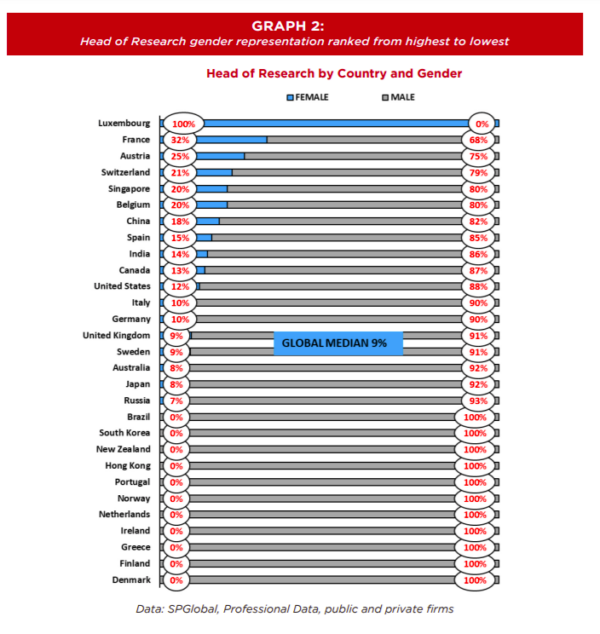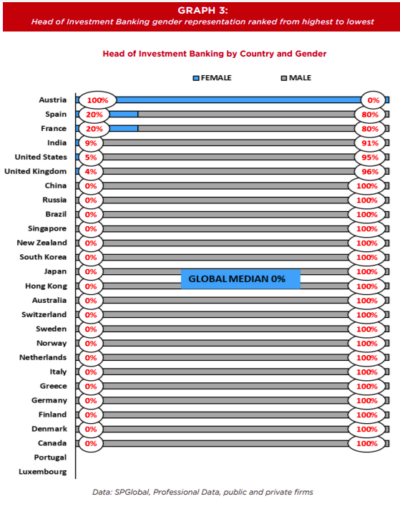We have taken a deep dive into the research on Women in finance you can read a few of our prior posts here, here, and here. We have covered In this original research, Tommi and I study data across 29 global markets and provide empirical data on the following question:
What percentage of CIO, Head of Research, and Head of Investment Banking roles do women fill in the global marketplace?
GLOBAL MEDIAN STATISTICS
The CIO, Head of Research, and Head of Investment Banking are fundamental positions in financial services. Our results are striking, but perhaps not surprising. We found global medians of only 9% for CIOs, 9% for Head of Research, and 0% for Head of Investment Banking for the markets we studied.
Quite a disappointing answer to the Trillion Dollar question: “Where are the Women?” at core positions of the financial service industry—namely investing and research (Basilico and Johnsen, 2019). As with other executive positions we have reported on, Europe leads the pack when it comes to diversification. Nine of thirteen countries scoring above the median for both the CIO role and the Head of Research were European. The data set included 9,667 functional positions for the CIO, Head of Research, and Head of Investment Banking roles in 29 countries combined. The countries included 25 developed markets and the 4 BRICs. All public and private firms in the finance industry were included regardless of market capitalization.
THE CHIEF INVESTMENT OFFICER
Out of 8,401 positions of Chief Investing Officer, we calculated the global median to be 9%. The results for each country are reported in graph 1. Thirteen countries scored above the median: nine European countries plus China, Russia, Singapore, and New Zealand. Austria at 20%, had the lowest gap in gender. Portugal, Italy, and Denmark reported no females in a CIO position. Russia and China scored at or above the global median while the remaining two BRICs, India and Brazil, scored at or below the median. The United States is positioned just below the global median at 8%.
Our findings are consistent with other research. For example, Adams et al. (2016), who studied 135,000
CFA charterholders in over 150 counties and reported less than 10 % in positions such as the CIO, CEO,
and CFOs were female.

THE HEAD OF RESEARCH
Identical to the CIOs, the global median for Heads of Research was 9%. Results from analyzing 822 positions are presented in graph 2. There were eleven countries with no female representation in this position including Denmark, Finland, Greece, Ireland, Netherlands, Portugal, Norway, Hong Kong, New Zealand, South Korea, and Brazil. Austria, at 20%, had the highest female representation. For the BRICs: India and China scored at or above the global median while Brazil and Russia were well below the median. Ten European countries along with the United States and Canada again scored well above the median.

THE HEAD OF INVESTMENT BANKING
We looked at 444 Heads of Investment Banking. The global median was 0%. The vast majority (nineteen) of the countries do not have any female representation in the IB role. Those that do report women in this role include Austria (at 100%! But there were only 2 positions), Spain, France, India, and the US. With the exception of Austria, the percentages ranged from 5% to 20%

What are the Academic Insights?
There is a “Pink” elephant in the room. The paucity of women in the key investment and decisión-making roles in finance is that “pink” elephant. While women are represented at 33%, 37%, and 63% in the law, medical, and accounting professions, respectively (Morningstar 2016), the percentage of female investment decision-makers in investment pales in comparison at less than 10%. And it gets worse if we look at sub-sectors. Take private equity, it’s 6% (Lietz, 2011), hedge funds at 3% (Soloway, 2011), or investment banking documented in this scorecard, at a global median of 0%.
This comes as no surprise as there is abundant evidence in the literature that describes Investment Banking as “hyper-masculine and patriarchal” (Neck, 2015; Sheerin and Linehan, 2018). The déficit is quite significant, despite the number of initiatives that are taking place. State Street’s Fearless Girl campaign in 2017, called on its portfolio companies to increase the number of women on their boards. Goldman Sachs announced that as of summer 2020 it would not help companies go public unless they have at least one diverse board member.
A legitimate question is whether the performance of female leaders in this sector compares unfavorably to their male counterparts. On the contrary, there is quite a bit of anecdotal evidence found in business news stories and academic research that indicates the performance of women in investment management is equal to, or in some cases, better than their male counterparts (Basilico and Johnsen, 2019).
So why the underrepresentation? Is the expectation of having a career in finance a function of gender? Are there prerequisite personality traits necessary for success in finance? A study by Sheerin (2015) provides some colorful insight:
“Women feel they have to adopt wolfish characteristics of assertiveness and confidence and conform to the masculine ideology.”
Apparently, women believe they need to behave like men in order to survive and succeed. Underlying that belief is the notion that men are advantaged and women must work harder for the same rewards (Brett and Stroh, 2003). Sheerin argues that media framing bears some of the blame. Media framing involves the social construction of a social phenomenon – by mass media sources, political or social movements, political leaders, or other actors and organizations. This is accomplished through the media’s choice of certain words and images to cover a story and possibly bring about change. However, a study by Sheerin and Garavan (2021), found that media in this space “potentially played a part in reproducing patriarchal power relations and shifting the blame for the marginalization of women, away from organizations, and towards women themselves”. Further, it seems that Investment Banking organizations ignore the negative framing of their own behavior, culture, and practices around gender and leadership.

You can find a pdf version of this scorecard here
REFERENCES
Adams, R.B., Barber, B.M. and T. Odean, Family, Values and Women in Finance, working paper Basilico, E. and T.Johnsen, 2019, Women in Finance: What Does the Research Show, in “Smart(er) Investing”, Palgarve MacMillan
Brett, J.M. and Stroh, L.K.,2003, Working 61 Plus Hours a Week: Why Do Managers Do It?, Journal of Applied Psychology
Lietz, N.G., 2011. Cloistered in the Pink Ghetto: Women in Private Equity, Real Estate and Venture Capital, Harvard Business Review.
Dossi, G., Figlio, D., Giuliano, P., and P. Sapienza, 2020, The Family Origin of the Math Gender Gap is a White Affluent Phenomenon, NBER Working Paper Johnsen, T., and E. Basilico, 2021, Women in Finance Scorecard, AcademicInsightsonInvesting.com
Neck, C., 2015, Disappearing Women. Why Do Women Leave Senior Roles in Finance? Further Evidence, Australian Journal of Management
Sheerin, C., 2015, The (She)Wolf of Wall Street: Myth or Reality, Accounting, Finance and Governance Review
Sheerin, C. and M. Linehan, 2018, Gender Performativity and Hegemonic Masculinity in Investment Management, Gender in Management: an International Journal
Sheerin, C. and T. Garavan, 2021, Female leaders as ‘Superwomen’: Post-global financial crisis media framing of women and leadership in investment banking in UK print media 2014–2016, Critical Perspectives on Accounting
About the Author: Elisabetta Basilico, PhD, CFA
—
Important Disclosures
For informational and educational purposes only and should not be construed as specific investment, accounting, legal, or tax advice. Certain information is deemed to be reliable, but its accuracy and completeness cannot be guaranteed. Third party information may become outdated or otherwise superseded without notice. Neither the Securities and Exchange Commission (SEC) nor any other federal or state agency has approved, determined the accuracy, or confirmed the adequacy of this article.
The views and opinions expressed herein are those of the author and do not necessarily reflect the views of Alpha Architect, its affiliates or its employees. Our full disclosures are available here. Definitions of common statistics used in our analysis are available here (towards the bottom).
Join thousands of other readers and subscribe to our blog.

